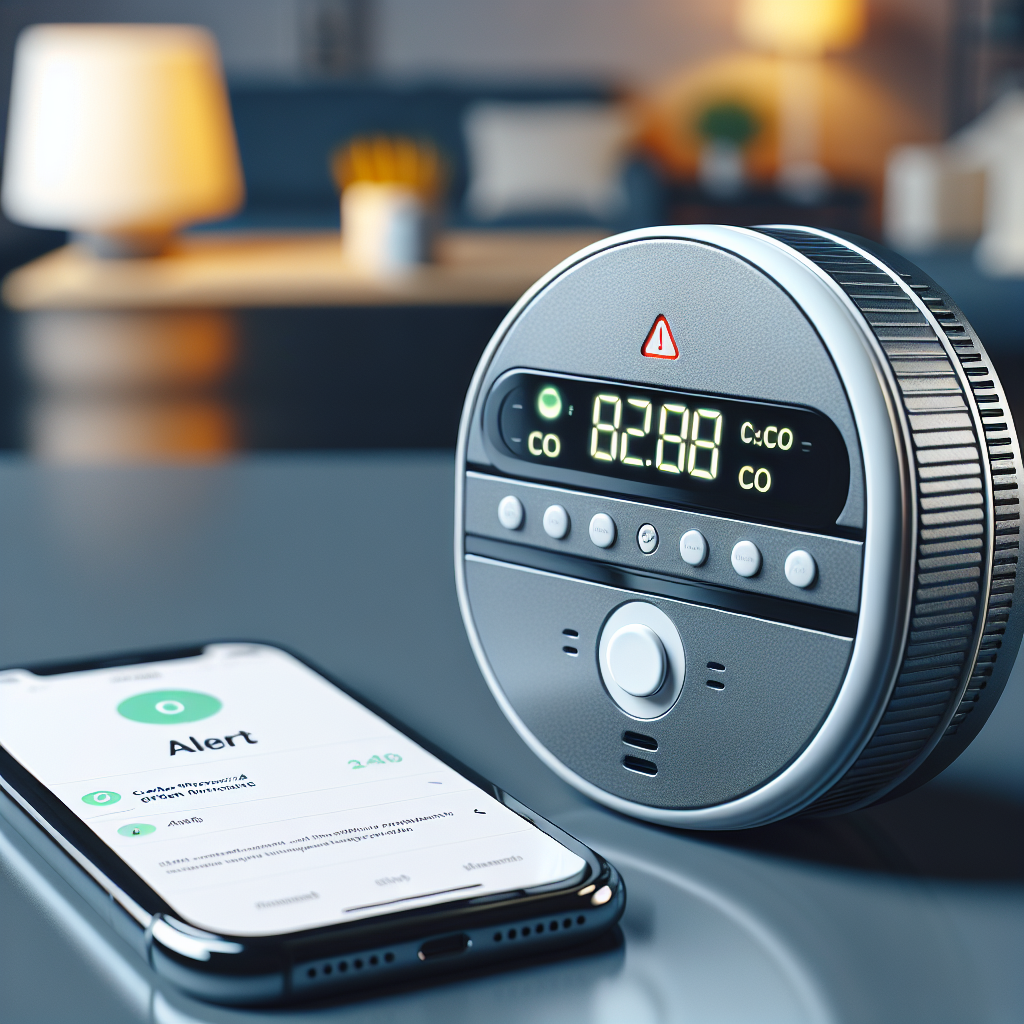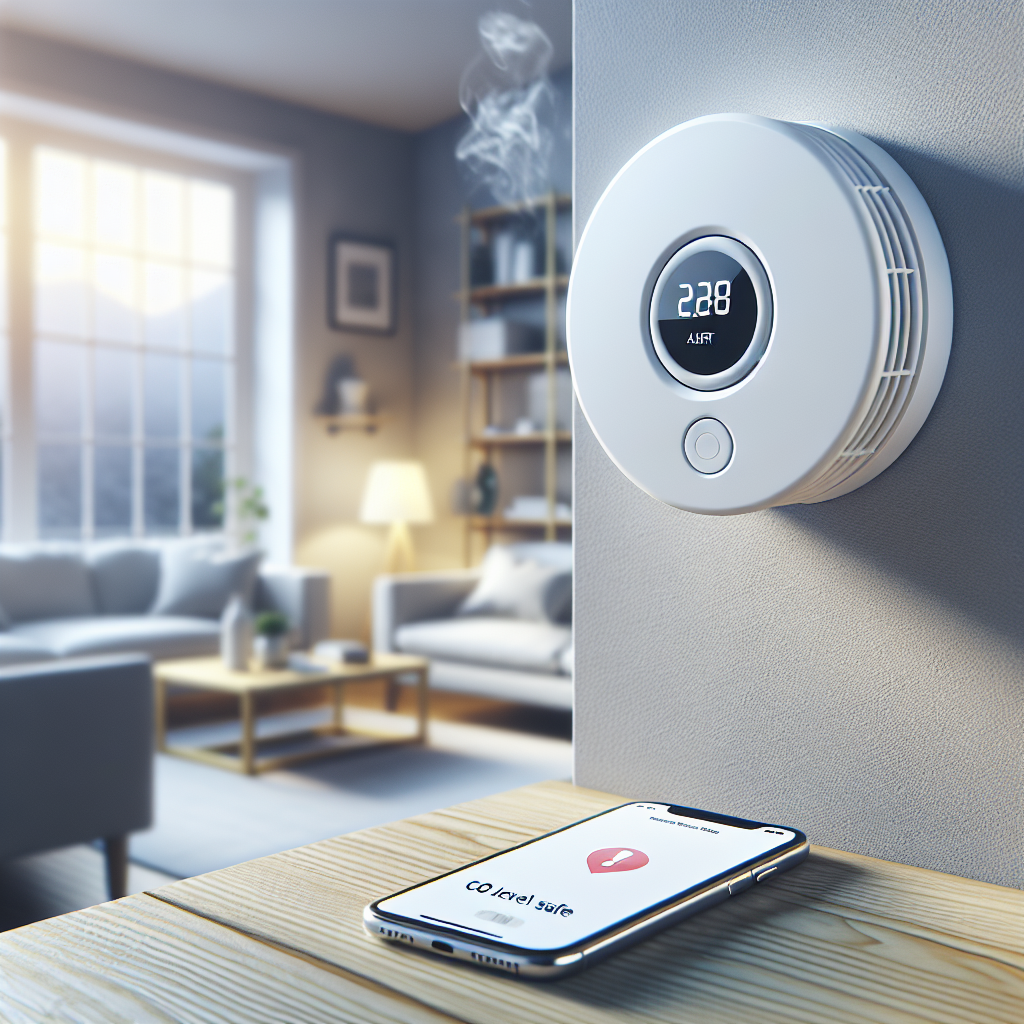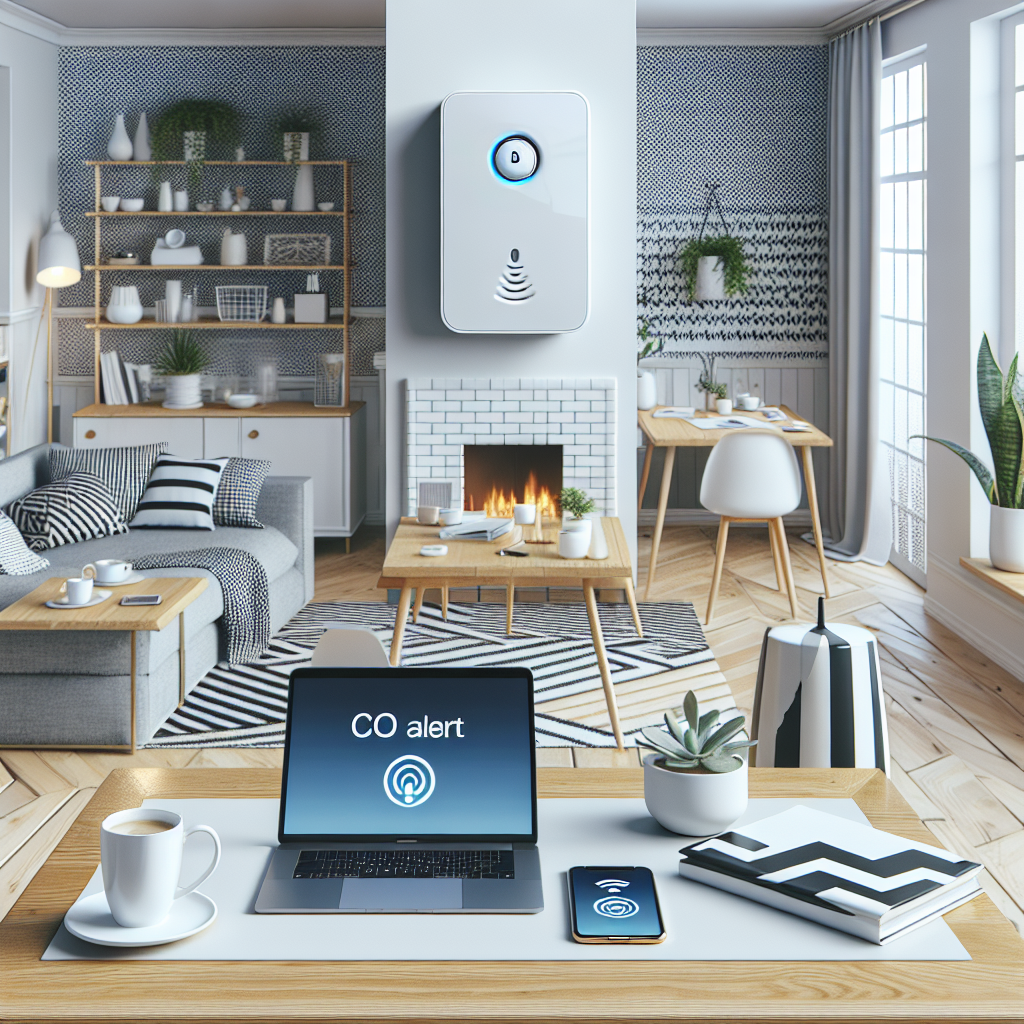In today’s technology-driven world, carbon monoxide detectors with smartphone alerts have become an essential safety measure for every household. These intelligent devices are designed to detect the presence of deadly carbon monoxide gas and immediately alert you on your smartphone, ensuring the safety of your loved ones even when you are away from home. With convenient push notifications and real-time monitoring, these detectors provide peace of mind and a sense of security like never before. Say goodbye to relying solely on traditional alarms and embrace the advanced protection offered by carbon monoxide detectors with smartphone alerts.
The Importance of Carbon Monoxide Detectors
-
Understanding the dangers of carbon monoxide
Carbon monoxide, often referred to as the “silent killer,” is a colorless, odorless gas that can be extremely dangerous when inhaled in high concentrations. It is produced by the incomplete burning of carbon-based fuels, such as gas, oil, wood, and coal. When carbon monoxide is released into an enclosed space, it can build up quickly and become lethal. Symptoms of carbon monoxide poisoning can be subtle and often mistaken for other illnesses, making it crucial to have a detection system in place. -
Legal requirements and safety standards for carbon monoxide detectors
Many jurisdictions have recognized the importance of carbon monoxide detectors and have implemented laws requiring their installation in residential and commercial buildings. These laws are in place to protect occupants from the harmful effects of carbon monoxide exposure. Additionally, safety standards for carbon monoxide detectors have been established to ensure their effectiveness and reliability. It is essential to adhere to these regulations to maintain a safe environment and prevent carbon monoxide-related incidents.
Evolution of Carbon Monoxide Detector Technology
Traditional Carbon Monoxide Detectors
- How traditional detectors work
Traditional carbon monoxide detectors operate based on electrochemical sensors or biomimetic sensors. Electrochemical sensors contain electrodes submerged in a chemical solution that reacts to carbon monoxide. When carbon monoxide is present, it triggers a chemical reaction that generates an electrical current, setting off the alarm. Biomimetic sensors mimic the way hemoglobin in the human body reacts to carbon monoxide, changing color when exposed to the gas. This color change is then detected by the device, prompting the alarm to sound.
- Limitations of traditional carbon monoxide detectors
Traditional carbon monoxide detectors have a few limitations that can compromise their effectiveness. One major drawback is their reliance on batteries, which can fail or run out without warning, leaving the device non-functional. Additionally, traditional detectors are usually standalone units that only emit an audible alarm within the vicinity of the gas leak. This can be problematic if occupants are not at home or if the alarm is not heard due to distance or hearing impairments. Furthermore, traditional detectors do not offer remote monitoring or alerts, meaning users must be physically present to hear the alarm and take necessary action.
Introduction of Smartphone Alerts
Evolution of Carbon Monoxide Detector Technology
Smartphone alerts have revolutionized the functionality of carbon monoxide detectors, offering a new level of convenience and safety to homeowners. Here are some key details to consider:
- Real-time Notifications: Smartphone-connected detectors provide real-time alerts directly to the user’s phone, ensuring immediate awareness of any potential carbon monoxide leaks.
- Remote Monitoring: With smartphone alerts, users can remotely monitor their homes even when they are away, allowing for proactive measures to be taken in case of an emergency.
- Integration with Smart Home Systems: These detectors can often be integrated with smart home systems, allowing for seamless automation and synchronization with other devices for enhanced control and efficiency.
- Detailed Insights: Smartphone alerts can provide detailed insights into carbon monoxide levels, trends, and patterns over time, enabling users to make informed decisions about their safety measures.
- Customizable Settings: Users can customize alert preferences and settings based on their individual needs and preferences, ensuring a personalized experience tailored to their specific requirements.
Key Features of Carbon Monoxide Detectors with Smartphone Alerts

– Remote monitoring capabilities
– Carbon monoxide detectors with smartphone alerts offer the convenience of remote monitoring, allowing users to check the status of their detector from anywhere. This feature is particularly beneficial for individuals who travel frequently or have vacation homes, providing them with peace of mind knowing they can monitor their home’s safety remotely.
– By connecting the detector to a smartphone app, users can receive updates on the detector’s battery life, sensor status, and overall functionality. This real-time information ensures that users are always aware of their home’s carbon monoxide levels, even when they are not physically present.
- Real-time alerts and notifications
- One of the key features of carbon monoxide detectors with smartphone alerts is the ability to receive real-time alerts and notifications directly to the user’s smartphone. In the event of a high carbon monoxide level being detected in the home, the detector will immediately send an alert to the connected smartphone, allowing users to take prompt action to ensure their safety.
-
These alerts can be customized based on the user’s preferences, such as setting different notification tones for varying levels of carbon monoxide detection. This level of customization ensures that users are alerted in a timely and effective manner, helping them respond quickly to any potential threats.
-
Integration with smart home systems
- Carbon monoxide detectors with smartphone alerts are designed to seamlessly integrate with smart home systems, allowing users to centralize their home monitoring and automation. By connecting the detector to a smart home hub, users can access all their home’s security features in one place, making it easier to manage and monitor their overall safety.
- Through integration with smart home systems, users can also set up automation rules based on carbon monoxide levels. For example, users can program their smart thermostat to automatically shut off in the event of a high carbon monoxide alert, helping to prevent the circulation of harmful gases throughout the home. This level of integration enhances the overall safety and convenience of using a carbon monoxide detector with smartphone alerts.

Addressing Common Concerns and Misconceptions
When it comes to carbon monoxide detectors with smartphone alerts, there are several common concerns and misconceptions that may arise. Addressing these issues can help users make informed decisions about integrating this technology into their homes.
Battery life and power source reliability
One of the primary concerns with carbon monoxide detectors with smartphone alerts is the battery life and power source reliability. Users often worry about the need to constantly monitor and replace batteries in these devices. However, many modern carbon monoxide detectors come with long-lasting batteries that can provide reliable power for years without needing frequent replacements. Additionally, some models offer the option of connecting to a power source, providing an extra layer of reliability for continuous operation.
Privacy and security of smartphone-connected devices
Privacy and security are significant concerns when it comes to any smartphone-connected device, including carbon monoxide detectors. Users may worry about potential data breaches or unauthorized access to their devices. To address these concerns, manufacturers implement robust encryption protocols and secure connection methods to ensure that the data transmitted between the detector and the smartphone remains private and secure. Additionally, users can take steps to secure their smartphones, such as using strong passwords and enabling two-factor authentication, to enhance the overall security of the system.
Compatibility with different smartphone platforms

Another common misconception is the compatibility of carbon monoxide detectors with various smartphone platforms. Some users may believe that these devices are only compatible with specific operating systems, limiting their options based on the type of smartphone they own. However, many manufacturers design their detectors to be compatible with a wide range of smartphone platforms, including both iOS and Android. This ensures that users can receive alerts and notifications regardless of the type of smartphone they use, offering a seamless experience across different devices.
Choosing the Right Carbon Monoxide Detector with Smartphone Alerts
When considering a carbon monoxide detector with smartphone alerts, there are several key factors to keep in mind to ensure you select the most suitable option for your needs. Here are some important considerations to take into account:
-
Detection Technology: Look for detectors that utilize advanced sensing technologies to accurately detect carbon monoxide levels in your home. Opt for models with electrochemical sensors for precise monitoring.
-
Smartphone Compatibility: Ensure that the carbon monoxide detector is compatible with your smartphone operating system, whether it’s iOS or Android. Check if the accompanying app offers seamless connectivity and timely alerts.
-
Alert System: Evaluate the alert system of the detector, including the sound alarms and smartphone notifications. Choose a model that provides loud and distinct alerts both at home and on your phone for enhanced safety.
-
Battery Life: Consider the battery life of the detector, especially for wireless models that rely on batteries. Select a detector with long-lasting batteries or a reliable power source to avoid disruptions in monitoring.
-
Integration with Smart Home Devices: If you have a smart home setup, look for carbon monoxide detectors that can integrate with other smart devices for a comprehensive home safety network. Compatibility with platforms like Google Home or Amazon Alexa can be beneficial.
When researching the top-rated carbon monoxide detectors with smartphone alerts on the market, consider factors such as brand reputation, user reviews, and additional features offered by each model. Conduct thorough research to ensure you make an informed decision and prioritize the safety of your household.
Installation and Maintenance Tips for Optimal Performance
Proper placement of detectors in the home:
-
Mount detectors at least 5 feet from the ground: For accurate readings, install carbon monoxide detectors at a height of at least 5 feet above the floor, as CO is slightly lighter than air and tends to rise.
-
Install detectors near bedrooms: Place detectors near sleeping areas to ensure that occupants can hear the alarm and respond promptly in case of a leak.
-
Avoid placing detectors near windows or vents: To prevent false alarms, avoid mounting detectors near windows, doors, vents, or areas with high humidity or temperature fluctuations.
Regular testing and maintenance routines:
-
Test detectors monthly: Press the test button on your carbon monoxide detector monthly to ensure it is functioning properly.
-
Replace batteries annually: Change the batteries in your detector at least once a year, or as recommended by the manufacturer, to guarantee continuous operation.
-
Replace detectors every 5-7 years: Carbon monoxide detectors have a limited lifespan. Replace your detectors every 5-7 years to maintain optimal performance.
Troubleshooting common issues with smartphone-connected detectors:
-
Check Wi-Fi connectivity: Ensure that your detector is properly connected to your home Wi-Fi network to receive smartphone alerts. Weak or lost connections can prevent timely notifications.
-
Update the detector’s firmware: Regularly check for firmware updates for your smart carbon monoxide detector to fix bugs, improve performance, and enhance features such as smartphone alerts.
-
Contact customer support: If you encounter persistent issues with your smartphone-connected detector, reach out to the manufacturer’s customer support for troubleshooting assistance and guidance on resolving connectivity issues.
FAQs: Carbon Monoxide Detectors with Smartphone Alerts
Can I receive notifications on my smartphone if my carbon monoxide detector detects a problem?
Yes, carbon monoxide detectors with smartphone alerts can send notifications directly to your phone in real-time if they detect elevated levels of carbon monoxide in your home. This feature allows you to quickly take action to protect yourself and your family from potential danger.
How do carbon monoxide detectors with smartphone alerts work?
Carbon monoxide detectors with smartphone alerts are equipped with Wi-Fi connectivity that allows them to communicate with your smartphone through a dedicated app. When elevated levels of carbon monoxide are detected, the detector sends a signal to the app, which then sends a notification to your phone, alerting you to the potential danger.
Are carbon monoxide detectors with smartphone alerts easy to install?
Yes, carbon monoxide detectors with smartphone alerts are typically easy to install and can be set up in just a few simple steps. Most detectors come with clear instructions and can be easily mounted on a wall or ceiling. Additionally, the accompanying app usually guides you through the setup process, making installation quick and hassle-free.
Can I monitor multiple carbon monoxide detectors in different locations from one app?
Yes, many carbon monoxide detectors with smartphone alerts allow you to monitor multiple detectors in different locations from a single app. This feature is especially useful for homeowners with multiple levels or buildings on their property, as it provides centralized monitoring and notifications for all detectors, ensuring maximum safety and peace of mind.